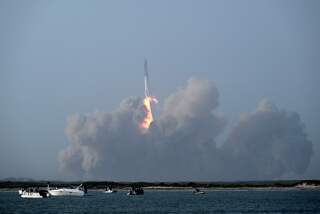NASA appears to no longer be shooting for the stars
- Share via
Reporting from Sandusky, Ohio — In a cavernous structure at NASA’s Plum Brook Station near Lake Erie, a concrete chamber five stories high rises from the ground. Its walls are 2 feet thick to withstand the blast of powerful gas-operated horns strong enough to destroy human organs.
The $150-million facility was built to contain the next-generation manned spacecraft for the Constellation program, NASA’s project to send humans back to the moon. It is the largest acoustic test chamber in the world, created to buffet the spacecraft with intense sound waves, simulating the stresses of launch.
The only problem is that the Constellation program almost certainly will be dead within months.
President Obama in January proposed cancelling the troubled moon program, and a key Senate committee voted this week to kill Constellation.
Despite the apparent kiss of death, construction continues at Plum Brook Station and other NASA centers and at private aerospace companies across the nation, where more than 14,000 people are still working on Constellation. Under pressure from Congress, NASA has been spending an average of about $9 million a day on the project.
After accomplishing so much in space for half a century, the nation now appears to lack not only the resources to mount a major human space program, but also the political will to eliminate the thousands of jobs connected with it.
“It is a sad spectacle,” said Loren Thompson, a longtime aerospace policy expert in Washington, referring to the dual-edged political sword that has constrained the once ambitious U.S. space program. “It is devolving into everybody trying to protect their home turf.”
Veteran space industry observers say the manned space program is in deeper trouble and greater turmoil than at any time since the U.S. landed men on the moon more than 40 years ago.
“The choice is: Do we have a space program or a jobs program, because we can’t have both,” said Jeff Greason, president of XCOR Aerospace Inc. in Mojave and a member of a presidential panel that delivered a scathing assessment of the space program last year.
Politicians cannot agree on long-term goals for the human spaceflight program, and the vast network of NASA facilities and private contractors is unable to make plans that keep pace with political action in the capital.
In Texas, Alabama, Florida, Louisiana, Mississippi and Ohio, NASA is going forward with new test facilities, machine shops and assembly rooms, among other things that were started for the Constellation program.
At Marshall Space Flight Center in Alabama, where NASA is developing the new J-2X rocket engine for Constellation, a spokeswoman said officials had not received guidance about what will happen after the end of the current fiscal year.
“The space program has never been in as much disarray as it is now,” Thompson said.
The manned space program is powered by $9 billion of NASA’s $18.7-billion budget this fiscal year and creates jobs by the tens of thousands across the country.
It is, by all accounts, a Cadillac enterprise, driven by high-profile past failures that have forced NASA into an extraordinarily risk-averse — and expensive — approach to spaceflight.
The Plum Brook acoustic chamber is part of that obsessive safety culture. It was sized to accommodate the entire Altair lander, which was originally designed to ferry as many as four astronauts to the lunar surface.
The planning for Plum Brook and a slew of other Constellation facilities began not long after the 2004 space vision proposed by President George W. Bush. One year after the Columbia space shuttle accident, Bush said the Constellation would start flying by 2012.
The program meant a new pot of money for NASA, including a $1.2-billion contract to build the J-2X and $180 million to develop a new spacesuit for the moon program.
But, according to a report last year from the presidential panel of space experts, the program was never adequately funded, receiving perhaps only a third of what it needed to meet its objectives. The project was estimated to cost $240 billion but was getting about $3 billion per year.
“We were on an unsustainable path,” Greason said. “So change of some kind was inevitable.”
When Obama said he wanted to kill the Constellation program, it ignited a political backlash. Congress was reluctant to cancel it, wanting to preserve jobs and expertise in the nation’s industrial base.
The battle over Constellation has revolved largely around jobs at NASA’s major centers in Texas, Florida and Alabama. But the termination of Constellation also threatens companies that have long supported NASA, such as rocket engine manufacturers Pratt & Whitney Rocketdyne in Canoga Park and ATK Aerospace Systems in Utah.
A possible compromise was struck last week by a Senate committee, but only after jobs were preserved. The Senate Commerce, Science and Transportation Committee agreed to cancel Constellation but voted to add $1 billion to keep the space shuttle flying through next summer and possibly much longer to preserve jobs. The space shuttle was supposed to be retired this year.
The compromise was consistent with the Obama administration’s strategy of shifting focus to a new breed of private launch companies to ferry astronauts to low Earth orbit to avoid the high cost and slow pace of development by government-run programs.
Space Exploration Technologies Corp., or SpaceX, has a NASA contract to supply the space station with cargo and eventually hopes to develop a spacecraft that can carry up to seven astronauts into orbit. So far, the Torrance-based company has developed its Falcon family of rockets and conducted six unmanned test flights.
“NASA used to be allowed to take more risks,” said Kenneth Bowersox, a veteran astronaut who is now a vice president at SpaceX. “A failure can paralyze them for years.”
The NASA centers have begun to sense the shift and are trying to market their capabilities to the new era.
David L. Stringer, a retired Air Force brigadier general who is director of Plum Brook, argued that even without Altair, the center’s acoustic test chamber will ultimately be useful for future programs, whatever they are.
Stringer is promoting a plan to build a $30-million runway at Plum Brook so spacecraft can be flown directly into the center, rather than to airports near Cleveland. Plum Brook has unique testing facilities, including the world’s largest thermal vacuum chamber, which can simulate the conditions of deep space.
But experts worry that a loss of expertise within NASA could drain away the ambition to put humans in space, which has been the driving force of the space program for more than 50 years.
“What is really happening here is the end of the U.S. human space exploration program,” Thompson said. “It is emblematic of a shortening of American horizons.”
More to Read
Inside the business of entertainment
The Wide Shot brings you news, analysis and insights on everything from streaming wars to production — and what it all means for the future.
You may occasionally receive promotional content from the Los Angeles Times.











